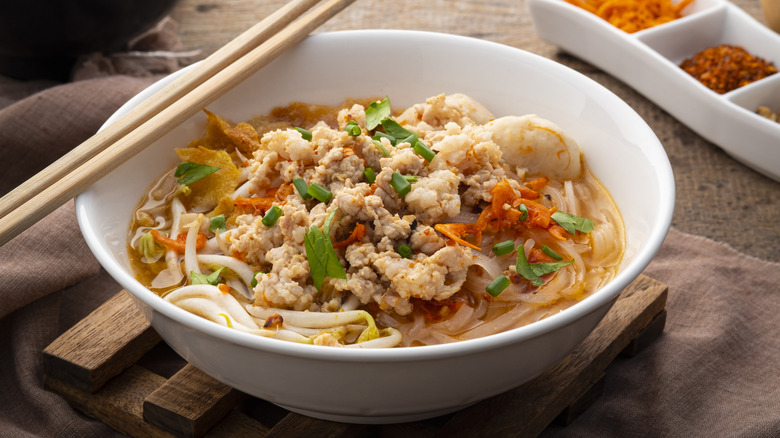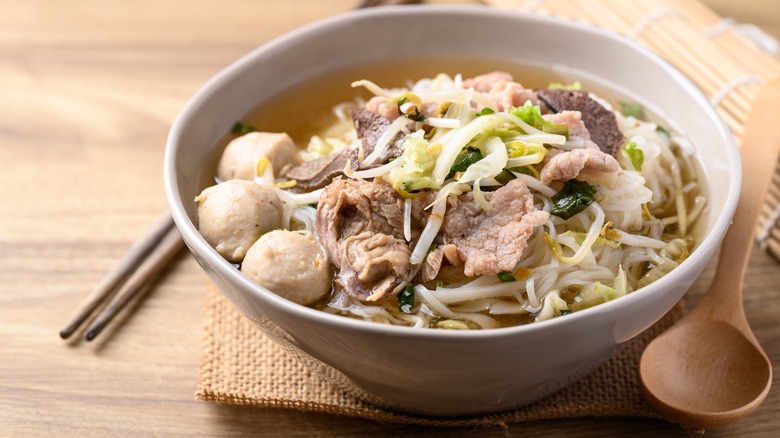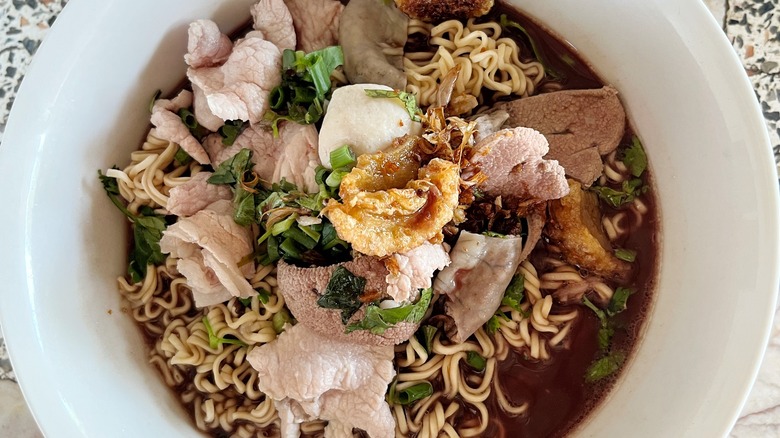The Difference Between Light And Dark Broth In Thai Noodle Soup
Noodle soups are a prominent and delicious part of Thai cuisine. These comforting dishes range broadly in terms of style and flavor, in part because of the different kinds of broths used in various dishes. Thai noodle soups generally feature either light or dark broth, and the difference between the two styles is important to understand — whether you're cooking a Thai-inspired dinner recipe at home or ordering a tasty bowl in a restaurant.
In Thai cuisine, light broth is made from pork or chicken stock, and is relatively simple in terms of ingredients. Salt, sugar, soy sauce, and fish sauce are added to the mix along with pepper, radish, and cilantro stems. Dark broth, on the other hand, contains a lot more aromatics, herbs, and spices. Black soy sauce contributes to its rich color, and dark broth often features cinnamon, galangal, and star anise. Both varieties are staples in Thai cooking, and each one serves as the base for certain types of noodle soup dishes.
When to use each variety of broth
Light broth, which is called nam sai, meaning "clear broth," serves as the base for a variety of soups. It's the foundation for dishes like Glass Noodle Soup, which is a comforting bowl that usually features chicken or pork meatballs. It can also be used in Guay Tiew Tom Yum, which is a hot and sour noodle soup that, unlike other Tom Yum soup recipes, doesn't include lemongrass or galangal. Using light broth is a great way to showcase and balance the sweet, spicy, and sour flavors that make Thai cuisine so unique. Since it's not as rich as dark broth, soups made with light broth are perfect for lunch, when you're feeling under the weather, or even on a hot day.
Dark broth, nam kon in Thai, on the other hand, can be used as the base for heartier soups like duck noodle soup and beef noodle soup. It's also a key ingredient in Thai Boat Noodles, a dish whose name comes from the fact that it was originally sold on canal boats in Bangkok. It can also be used to braise proteins (including meat that will eventually serve as an ingredient in dark broth-based soups). Noodle soups made with dark broth are richer, more intense, and often more stew-like.
Tips for making and using Thai broths
Making dark broth from scratch takes time — you'll need to simmer it for a couple hours. It'll probably also require a trip to the butcher, since many recipes call for ingredients like a whole duck or pork blood. Luckily, you don't have to make dark broth from scratch as some Thai recipes start with store-bought bone broth.
Store-bought bone broth is different from other types of store-bought stock since it's generally simmered for longer, which results in a saltier and more flavorful product. There are different types of bone broth on the market, so you'll want to match the type of bone broth to the type of protein in your soup (for example, use beef bone broth if you're making a beef noodle soup). If you're using store-bought bone broth instead of homemade dark broth, you'll need to add key ingredients like black soy sauce, cinnamon, and star anise.
If you're making light broth from scratch, be sure to scrub the bones before simmering, and never boil the stock to ensure the broth stays clear. But you can save time here too as many recipes, like this Thai coconut chicken soup, call for store-bought chicken broth instead of homemade. If you're using the store-bought stuff, you can add garlic, daikon, scallions, ginger, and cilantro stems to the broth to make it more akin to Thai light broth. You don't need to use low-sodium store-bought broth here, since they're usually milder in flavor.


